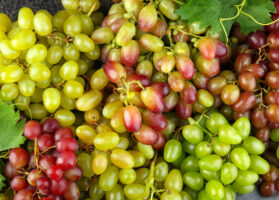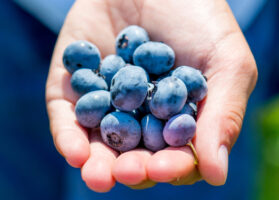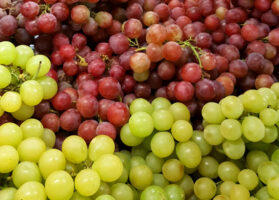Chilean grapes look for big rebound

Overview of the upcoming Chilean table grapes season, complemented by charts from Agronometrics. Original published on November 15, 2021.
Chilean grape production should see a big rebound in the 2021-22 marketing year, according to a new estimate from the U.S. Department of Agriculture Foreign Agricultural Service.
Chilean grape output will bounce back from the decline caused in the 2020-21 season from heavy rain, the report said.
At 805,000 metric tons, the USDA’s estimate of Chilean grape production for 2021-22 is up 22% from the 2020-21 season. Chilean grape exports also will increase 22.9% to 645,000 metric tons in the 2021-22 season, according to the USDA estimate.

Source: USDA Market News via Agronometrics.
(Agronometrics users can view this chart with live updates here)
Eric Coty, vice president of South American operations for The Oppenheimer Group (Oppy), said the company has seen excellent growing conditions in Chile so far this season.
“We look forward to bringing proprietary premium varieties to market,” Coty said. “We will have quotable volumes from the start in January through May, keeping stores stocked and ads going. Oppy offers a range of Chilean options from pears, grapes, kiwifruit, citrus, pluots, plums, peaches, nectarines, cherries, berries, avocados, apricots and apples.”
Coty said Oppy’s Southern Hemisphere grape program will feature the Ocean Spray label, which he said carries 96% brand awareness. Oppy offers retailers a 12-month consumer brand for the grape category from Peru, Chile and Brazil, as well as South Africa, Mexico and California, he said.
The rebound in Chilean grape production is associated in part with increased production from new varieties planted in recent years and a return to more normalized climatic conditions, according to the USDA report.
Grape volumes were challenged because of rain in the 2020-21 season but all signs so far are pointing towards a good and fully productive season on grapes and all items, .said Bill Poulos, director of import grapes and stone fruit for Oppy.
In marketing year 2020-21 rainfall during the last week of January 2021 damaged the table grape crop that was ready for harvest in the central region of the country, specifically in the regions of Valparaíso, Metropolitana, and O’Higgins.
That rainfall pulled down Chilean grape production by 15.3%, according to the report, reaching 664,700 metric tons.
Marketing year 2020-21 revenues for producers, the report said, also were lower than initial expectations because of quality problems caused from excess moisture on the fruit.
The USDA said Chilean table grape planted area has been in decline for the past ten marketing years because margins have been very low for traditional grape varieties which are no longer appealing to consumers.

Source: USDA Market News via Agronometrics.
(Agronometrics users can view this chart with live updates here)
“Drought is also a problem that has caused a decline in productivity and thus a decrease in total table grape production volume for the past 12 years,” the USDA report said.
Labor is a worry for Chilean grape producers, the USDA said.
Producers have had trouble in finding workers to perform critical tasks, including pruning, harvest, selection, and packing, the according to the USDA report.
“Although there are many factors that explain the lack of workers, it is mostly attributed to travel restrictions and quarantines that were 1080x1080adopted to fight the COVID 19 pandemic,” the report said. “Many of the workers hired for the harvest and packing season are temporary workers that travel from other regions or countries.”
Managing resources also is critical, with goals including sustainable management, irrigation efficiency, variety selection, and crop protection against rain or wind.
During the past decade, the report said table grape producers have traded traditional varieties for more modern, productive seedless varieties. Now, orchards with new varieties are beginning to produce, and the USDA pushing up overall production volume, the USDA said.
Trade
Because of the rain in January 2021, the USDA said marketing year 2020-21 Chilean table grape exports declined by 13.1% in volume, totaling 525,419 metric tons through August.
Table grape export value declined by 10.8% totaling $826.1 million. The USDA report said the grapes exported after the rains did not arrive to export markets in good condition.
“Many of the grapes were rotten and had to be repacked upon arrival, thus decreasing revenues for exporters significantly,” the report said.
Looking up
For the upcoming 2021-22 season, the USDA report said table grape exports will total 645,000 metric tons, a 22.8% increase over last season. The U.S. remains the main market for Chilean table grape exports, the USDA report said, accounting for 48.5% of Chilean table grape exports.
In marketing year 2020-21, Chilean table grape exports to the U.S. totaled 254,811 metric tons, a 7.5% decrease compared with marketing year 2019-20.
Despite logistical challenges, Poulos said one advantage the industry has is that the Chilean bulk grapes are shipped in break bulk vessels. “As these vessels are unloaded at different terminals from container shipments, it will help volume bypass the current bottleneck,” he said.
China is the second market for Chilean grapes, totaling 78,117 metric tons in marketing year 2020-21, a 30.1% decline over marketing year 2019-20.
Phytosanitary issues
The USDA report said Chilean Ministry of Agriculture through the Agricultural and Livestock Service are implementing the 2021-22 National Program for the control of Grapevine Moth (Lobelia botrana). SAG’s control actions are mandatory for all table grapes (Vitis vinifera) throughout the areas producing table grapes in Chile.
European grapevine moth was eradicated from the U.S. in 2016 and is a serious pest concern. Chile is currently exporting table grapes to the U.S. using methyl bromide fumigation, according to the report. The current methyl bromide fumigation notably decreases the product quality and shelf life. In 2014, Chile’s Ministry of Agriculture presented a plan to control and eradicate European grapevine moth and asked USDA to consider importing table grapes from certain Chilean regions (Coquimbo and Atacama regions) under a systems approach, which would not require methyl bromide fumigation. Chile’s request to export table grapes to the U.S. under systems approach is still pending USDA-APHIS review, the report said.
The News in Charts is a collection of stories from the industry complemented by charts from Agronometrics to help better tell their story.
Access the original article with this (Link)






